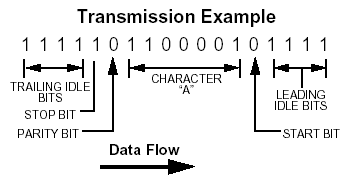Disadvantages Of Serial Transmission Definition

Serial and Parallel Transmission Digital data transmission can occur in two basic modes: serial or parallel. Data within a computer system is transmitted via parallel mode on buses with the width of the parallel bus matched to the word size of the computer system.

Data between computer systems is usually transmitted in bit serial mode. Golf clash apk hack. Consequently, it is necessary to make a parallel-to-serial conversion at a computer interface when sending data from a computer system into a network and a serial-to-parallel conversion at a computer interface when receiving information from a network. The type of transmission mode used may also depend upon distance and required data rate. Parallel Transmission In parallel transmission, multiple bits (usually 8 bits or a byte/character) are sent simultaneously on different channels (wires, frequency channels) within the same cable, or radio path, and synchronized to a clock.
Download Game PS2 ISO dan PS1 Terbaik - Daftar kumpulan iso terbaru ini sengaja saya buat, agar anda bisa dengan mudah menavigasi dan menemukan game yang. Download game ppsspp ukuran kecil dibawah 100 mb god of war APK game ppsspp ukuran kecil dibawah 100 mb god of war, MOD game ppsspp ukuran kecil dibawah 100 mb god of war Update 2016. Download game ps2 iso ukuran kecil. Kumpulan Game Ps1 / PSX Iso Android Ukuran Kecil Komplit. Kumpulan Game Ps1 / PSX Iso Android Ukuran Kecil Komplit Dark. Disini banyak sekali game ps2 yang bisa.
For example, a single transmission from a peripheral device using serial data might take only 6 bits, so the serial mechanism has a way to dictate how to signal things like an 'end of transmission.' Advantages and DIsadvantages.
Parallel devices have a wider data bus than serial devices and can therefore transfer data in words of one or more bytes at a time. As a result, there is a speedup in parallel transmission bit rate over serial transmission bit rate. However, this speedup is a tradeoff versus cost since multiple wires cost more than a single wire, and as a parallel cable gets longer, the synchronization timing between multiple channels becomes more sensitive to distance. The timing for parallel transmission is provided by a constant clocking signal sent over a separate wire within the parallel cable; thus parallel transmission is considered synchronous.
Serial Transmission In serial transmission, bits are sent sequentially on the same channel (wire) which reduces costs for wire but also slows the speed of transmission. Also, for serial transmission, some overhead time is needed since bits must be assembled and sent as a unit and then disassembled at the receiver. Serial transmission can be either synchronous or asynchronous.
In synchronous transmission, groups of bits are combined into frames and frames are sent continuously with or without data to be transmitted. In asynchronous transmission, groups of bits are sent as independent units with start/stop flags and no data link synchronization, to allow for arbitrary size gaps between frames. However, start/stop bits maintain physical bit level synchronization once detected. Applications Serial transmission is between two computers or from a computer to an external device located some distance away. Parallel transmission either takes place within a computer system (on a computer bus) or to an external device located a close distance away. A special computer chip known as a universal asynchronous receiver transmitter (UART) acts as the interface between the parallel transmission of the computer bus and the serial transmission of the serial port. UARTs differ in performance capabilities based on the amount of on-chip memory they possess.
Examples Examples of parallel mode transmission include connections between a computer and a printer (parallel printer port and cable). Most printers are within 6 meters or 20 feet of the transmitting computer and the slight cost for extra wires is offset by the added speed gained through parallel transmission of data. Examples of serial mode transmission include connections between a computer and a modem using the RS-232 protocol. Although an RS-232 cable can theoretically accommodate 25 wires, all but two of these wires are for overhead control signaling and not data transmission; the two data wires perform simple serial transmission in either direction. In this case, a computer may not be close to a modem, making the cost of parallel transmission prohibitive —thus speed of transmission may be considered less important than the economical advantage of serial transmission. Tradeoffs Serial transmission via RS-232 is officially limited to 20 Kbps for a distance of 15 meters or 50 feet. Depending on the type of media used and the amount of external interference present, RS-232 can be transmitted at higher speeds, or over greater distances, or both.